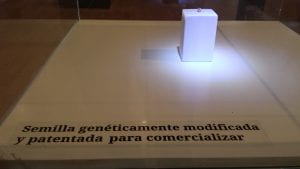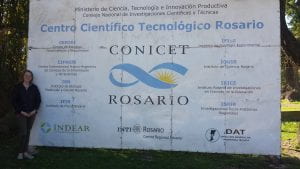As I was planning for this research project, I wasn’t anticipating including public discourse in my analyses because I didn’t know how I would find sources of information. In Rosario, it turned out to be quite easy. In the five days that I was there, I stumbled upon many public examples of conversations about biotechnology, including anti-Monsanto graffiti, the premiere of a documentary criticizing the region’s soybean production, and a science museum with several mentions of GMOs.
I also ended up hearing a lot of random people’s opinions on the matter in an exchanges that usually went as follows:
The setting: Me, chilling in a [bus station/taxi/guided tour/…] reveling in the fact that I’m blending in so well compared to my time in other foreign countries because there are plenty of blonde-haired, blue-eyed Argentines.
Random Argentine [bus passenger/taxi driver/tourist/…]: Where are you from?
Me: (Dang, it must have been my comfortable walking shoes that gave me away) the United States, Chicago to be exact.
Argentine: What are you doing here?
Me: I’m doing a study about GMOs here in Argentina
Argentine (seeming a bit suspicious of me): And are you for them or against them?
Me: I don’t have a very strong opinion because there are so many different types. What do you think?
Argentine: Well, I don’t know much, but my [brother/daughter/friend] told me about a [neighbor/community/person in a news story] that [said studies show they’re safe/banned GMOs/got cancer from the use of agrochemicals]. In any case, I just don’t think we know enough about them to know they’re safe…
Me: Oh okay, could you expand on that?
Argentine: [Lengthy explanation on what they’ve heard]
I want to emphasize two main themes from my conversations: first, that everyone either took a positive or negative stance on GMOs, with more people leaning negative. Second, that many people were critical of GMOs because they didn’t think that we know enough about them.
On the first point, you may be thinking, of course they’re going to have a positive or negative opinion: what other type exists? With some issues, especially political ones, there is no way to have a middle ground. With GMOs on the other hand, there is no biological factor stopping a farmer from using organic soil conservation techniques and planting a seed that has been genetically modifed. Nonetheless, in today’s system, herbicide tolerance is the most common trait, so it isn’t surprising that people equate GMOs with industrial agriculture and chemical application.
At the natural science museum in Rosario, there was a video about agriculture in one of the exhibits. It showed two types of agriculture: agroecology, represented by hard-working farmers, chirping birds, and glistening strawberries; and conventional agriculture, represented by big machines, flashing red warning noises, and endless fields of soybeans. When I asked the director of the video about its purpose, he said that he wanted to present another side of the story because in Rosario, there is a great deal of pro-GMO sentiment. This observation was interesting because people who were “pro-GMO” often said that most people were anti-GMO. The division into these conflicting sides fascinated me, and made me doubt whether the consensus could move to the middle even if new traits such as drought tolerance reduce the amount resources required for food production.
On the second point: a conversation I had with one of the scientists at INDEAR perhaps explains why the public feels like we don’t know enough about GMOs. The scientist said that on average, the scientific and regulatory process for developing a GM crop takes 13 years. 13 years. During this time, they test the trait in every way imaginable for possible health and environmental risks. The average person, however, only reads about the “discovery” of a new GM trait once it’s released, making it seem like a sudden phenomenon. I’m not sure if there’s a solution to this problem, but I think it arises from the contrasting priorities of the press and science: the media operates around strict deadlines, confirmed facts, and definite events; on the other hand, the scientific world progresses gradually and is reluctant to declare anything with certainty. It would would be difficult to write an intriguing story about a drought-resistant soybean that might be released in five years, but might also fall into a black hole of regulatory chaos and be put on hold for another decade. Thus, the public only hears about biotechnology when it’s released, not the years of research behind it.
Thanks for getting through a long post – I hope you found it interesting. I’ll post more photos once I figure out some technical problems. In the meantime, I’m currently waiting in the Buenos Aires airport to go to São Paulo. Hasta luego, Argentina and Olá Brazil!



